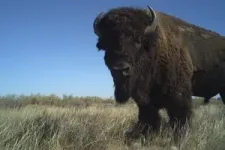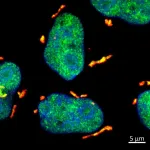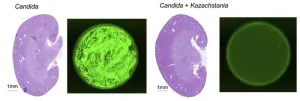(Press-News.org) One of the largest studies on wildlife activity—involving more than 220 researchers, 163 mammal species and 5,000 camera traps worldwide—reveals that wild animals react differently to humans depending on where the animals live and what they eat.
Bigger herbivores—plant-eating animals like deer or moose—tend to become more active when humans are around, while meat-eaters like wolves or wolverines tend to be less active, preferring to avoid risky encounters.
Urban animals like deer or raccoons may become more active around people, as they get used to human presence and find food like garbage or plants, which they can access at night. But animals living farther from cities and other developed areas are more wary of encountering people.
Wildlife during the pandemic ‘anthropause’
The new study, a collaboration across researchers from 161 institutions, used data from before and during the COVID-19 lockdowns to examine wildlife behaviour amid changing human activity levels.
“COVID-19 mobility restrictions gave researchers a truly unique opportunity to study how animals responded when the number of people sharing their landscape changed drastically over a relatively short period,” said lead author Dr. Cole Burton, an associate professor of forest resources management at UBC and Canada Research Chair in Terrestrial Mammal Conservation.
“And contrary to the popular narratives that emerged around that time, we did not see an overall pattern of ‘wildlife running free’ while humans sheltered in place. Rather, we saw great variation in activity patterns of people and wildlife, with the most striking trends being that animal responses depended on landscape conditions and their position in the food chain.”
In Canada, researchers monitoring areas such as Banff and Pacific Rim national parks, Cathedral, Golden Ears and South Chilcotin Mountains provincial parks, and the Sea-to-Sky corridor in B.C. found that carnivores like wolverines, wolves and cougars were generally less active when human activity was higher.
In several of these parks, and in cities such as Edmonton, large herbivores often increased their activity but became more nocturnal with the presence of more humans. Large carnivores were notably absent from the most human-dominated landscapes.
Preventing conflict through smart conservation measures
These findings highlight the importance of measures to minimize any detrimental effects of human disturbance on wildlife, including reducing overlaps that might lead to conflict.
“In remote areas with limited human infrastructure, the effects of our actual presence on wildlife may be particularly strong. To give wild animals the space they need, we may consider setting aside protected areas or movement corridors free of human activity, or consider seasonal restrictions, like temporary closures of campsites or hiking trails during migratory or breeding seasons,” said study co-author and UBC biologist Dr. Kaitlyn Gaynor.
She added that strategies must also fit specific species and locations. In more remote areas, keeping human activity low will be necessary to protect sensitive species. In areas where people and animals overlap more, such as cities, nighttime is an important refuge for wildlife, and keeping it that way can help species survive. Efforts may focus on reducing human-wildlife conflict after dark, such as more secure storage of trash bins to reduce the number of animals getting into human food sources, or use of road mitigation measures to reduce vehicle collisions.
The findings are particularly useful amid the surge in global travel and outdoor recreation post-pandemic, Dr. Burton added.
“Understanding how wildlife respond to human activity in various contexts helps us develop effective conservation plans that have local and global impact. For that reason, we are working to improve wildlife monitoring systems using tools like the camera traps that made it possible to observe animal behaviours during the pandemic.”
The study was published today in Nature Ecology and Evolution
Interview language(s): English (Burton, Gaynor)
To interview study authors, please contact lou.bosshart@ubc.ca or jillian.vandergeest@ubc.ca.
Media assets:
Camera trap images, infographic, video: Dropbox END
Global wildlife study during COVID-19 shows rural animals are more sensitive to human activity
Plant-eating animals more active, carnivores more cautious around humans
2024-03-18
ELSE PRESS RELEASES FROM THIS DATE:
Newly discovered link between FBXW7 mutations and EGFR signaling in colorectal cancer
2024-03-18
The Organoid group at the Hubrecht Institute have identified a new link between FBXW7 mutations and EGFR signaling activity. The FBXW7 gene is commonly mutated in colorectal cancer and such mutations have been associated with worse treatment outcome. The researchers used colon organoids and the CRISPR/Cas9 gene editing technique to investigate the consequences of multiple common FBXW7 mutations. Further understanding of the link with EGFR signaling could help improve treatment strategies for colorectal cancer. The research was published on March 14th in Proceedings of the national academies of sciences (PNAS).
Cancer is caused by the accumulation of mutations in different ...
Study eases concern at antipsychotics use in pregnancy
2024-03-18
The use of antipsychotics during pregnancy isn’t linked to childhood neurodevelopmental disorders or learning difficulties, UNSW Sydney-led study shows – giving assurance to those concerned about continuing their medications during pregnancy.
Antipsychotics – a branch of medication designed to treat schizophrenia and bipolar disorder – are important tools for mental health care management. They work by blocking the effect of dopamine, which can help reduce psychotic symptoms such as hallucinations or delusions.
These versatile ...
Peer-coaching helps socially marginalized individuals lower blood pressure
2024-03-18
For younger Black patients living in rural parts of the Southeastern United States, peer coaching is more effective than traditional clinical care in controlling high blood pressure, according to a new study led by investigators at Weill Cornell Medicine and NewYork-Presbyterian. The investigators learned that for people under age 60 who have persistently uncontrolled hypertension, the benefits of working with a peer health coach were equivalent to what would be expected from taking a low dose of blood pressure medication.
The findings were published March 18 in JAMA Internal Medicine. The randomized ...
Estimated childhood lead exposure from drinking water in Chicago
2024-03-18
About The Study: The findings of this study indicate that childhood lead exposure from drinking water is widespread in Chicago, and racial inequities are present in both testing rates and exposure levels. Machine learning may assist in preliminary screening for lead exposure, and efforts to remediate the effects of environmental racism should involve improving outreach for and access to lead testing services.
Authors: Benjamin Q. Huynh, Ph.D., of the Johns Hopkins University Bloomberg School of Public Health in Baltimore, is the corresponding author.
To access the embargoed study: Visit our For The Media website at this link https://media.jamanetwork.com/
(doi:10.1001/jamapediatrics.2024.0133)
Editor’s ...
How DHX9 stress granules protect daughter cells from UV-induced RNA damage
2024-03-18
Mothers and daughters have a strong bond, yet do you know that connections reminiscent of this close relationship extend all the way to the cellular level? During the process of cell division, new daughter cells inherit a mix of genetic material and other molecules from their mother cells. This inheritance includes both beneficial components, which can help them for a robust start in life, and potentially harmful mutations or damaged molecules, posing significant challenges for the newly born daughter cells. How daughter cells manage and ...
Discover BMB 2024 press materials available now
2024-03-18
Embargoed press materials are now available for Discover BMB, the annual meeting of the American Society for Biochemistry and Molecular Biology. Top scientists and educators in the field will gather at the meeting, March 23–26 in San Antonio.
Reporters are invited to attend an exciting lineup of in-person scientific sessions in San Antonio or access press materials electronically. Register now or find more information in the #DiscoverBMB newsroom. Please note that only a limited number of complementary on-site press passes will be issued, so advance registration is recommended.
Explore the schedule at a ...
Newly identified yeast could prevent fungal infections by outcompeting rivals, study suggests
2024-03-18
Researchers at the Weizmann Institute of Science in Israel have identified a yeast that could be used to prevent invasive candidiasis, a major cause of death in hospitalized and immunocompromised patients. The study, to be published March 18 in the Journal of Experimental Medicine (JEM), shows that the novel yeast lives harmlessly in the intestines of mice and humans and can displace the yeast responsible for candidiasis, Candida albicans.
Millions of microbial species live within or on the human body, many of them being harmless or even beneficial to human health. The microscopic yeast C. albicans is commonly found in the intestines ...
NIH studies find severe symptoms of “Havana Syndrome,” but no evidence of MRI-detectable brain injury or biological abnormalities
2024-03-18
EMBARGOED FOR RELEASE
Monday, March, 18,2024
10 a.m. EDT
Contact:
NIH Office of Communications and Public Liaison
NIH News Media Branch
301-496-5787
NIH studies find severe symptoms of “Havana Syndrome,” but no evidence of MRI-detectable brain injury or biological abnormalities
Compared to healthy volunteers, affected U.S. government personnel did not exhibit differences that would explain symptoms
Using advanced imaging techniques and in-depth clinical assessments, a research team at the National Institutes of Health (NIH) found no significant evidence of MRI-detectable brain injury, nor differences in most clinical measures compared to ...
Clinical, biomarker, and research tests among US government personnel and their family members involved in anomalous health incidents
2024-03-18
About The Study: In this exploratory study, there were no significant differences between individuals reporting anomalous health incidents and matched control participants with respect to most clinical, research, and biomarker measures, except for objective and self-reported measures of imbalance and symptoms of fatigue, posttraumatic stress, and depression. This study did not replicate the findings of previous studies, although differences in the populations included and the timing of assessments limit direct comparisons. ...
Neuroimaging findings in US government personnel and their family members involved in anomalous health incidents
2024-03-18
About The Study: In this exploratory neuroimaging study, there were no significant differences in imaging measures of brain structure or function between individuals reporting anomalous health incidents and matched control participants after adjustment for multiple comparisons. U.S. government personnel stationed internationally have reported anomalous health incidents, with some individuals experiencing persistent debilitating symptoms.
Authors: Carlo Pierpaoli, M.D., Ph.D., of the National Institute of Biomedical Imaging and Bioengineering in ...
LAST 30 PRESS RELEASES:
Numbers in our sights affect how we perceive space
SIMJ announces global collaborative book project in commemoration of its 75th anniversary
Air pollution exposure and birth weight
Obstructive sleep apnea risk and mental health conditions among older adults
How talking slows eye movements behind the wheel
The Ceramic Society of Japan’s Oxoate Ceramics Research Association launches new international book project
Heart-brain connection: international study reveals the role of the vagus nerve in keeping the heart young
Researchers identify Rb1 as a predictive biomarker for a new therapeutic strategy in some breast cancers
Survey reveals ethical gaps slowing AI adoption in pediatric surgery
Stimulant ADHD medications work differently than thought
AI overestimates how smart people are, according to HSE economists
HSE researchers create genome-wide map of quadruplexes
Scientists boost cell "powerhouses" to burn more calories
Automatic label checking: The missing step in making reliable medical AI
Low daily alcohol intake linked to 50% heightened mouth cancer risk in India
American Meteorological Society announces Rick Spinrad as 2026 President-Elect
Biomass-based carbon capture spotlighted in newly released global climate webinar recording
Illuminating invisible nano pollutants: advanced bioimaging tracks the full journey of emerging nanoscale contaminants in living systems
How does age affect recovery from spinal cord injury?
Novel AI tool offers prognosis for patients with head and neck cancer
Fathers’ microplastic exposure tied to their children’s metabolic problems
Research validates laboratory model for studying high-grade serous ovarian cancer
SIR 2026 delivers transformative breakthroughs in minimally invasive medicine to improve patient care
Stem Cell Reports most downloaded papers of 2025 highlight the breadth and impact of stem cell research
Oxford-led study estimates NHS spends around 3% of its primary and secondary care budget on the health impacts of heat and cold in England
A researcher’s long quest leads to a smart composite breakthrough
Urban wild bees act as “microbial sensors” of city health.
New study finds where you live affects recovery after a hip fracture
Forecasting the impact of fully automated vehicle adoption on US road traffic injuries
Alcohol-related hospitalizations from 2016 to 2022
[Press-News.org] Global wildlife study during COVID-19 shows rural animals are more sensitive to human activityPlant-eating animals more active, carnivores more cautious around humans




